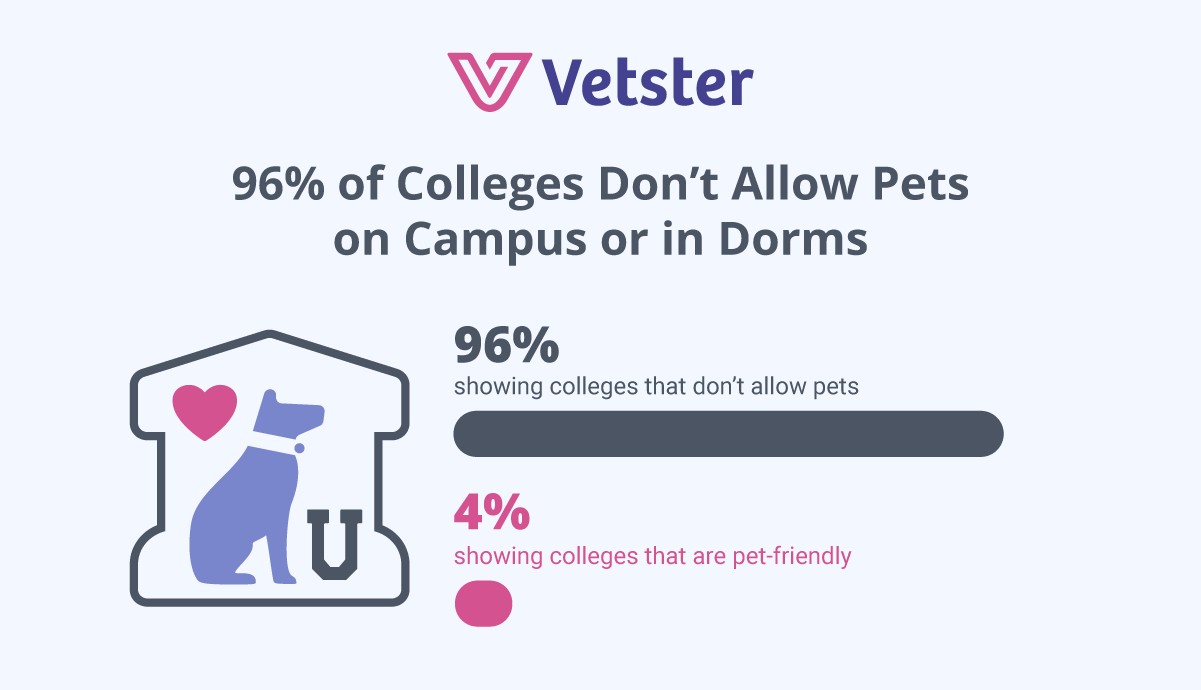Bringing your pet to college

Pets are a great way to relieve the stress and anxiety that comes along with life as a college student. Pets can make you happier, healthier, and provide companionship when you are adjusting to a new environment where you may not know many people. However, it is not always easy to keep a pet in a college dorm. It also may not be in your pet’s best interests, so in some cases you may want to consider leaving your beloved pet at home. Keep reading to find out everything you need to know about keeping a pet in your college dorm.
Can you keep pets in your college dorm?
Some college dorms are open to students keeping pets, as long as the pets are not disruptive to other students sharing the space. Although the number of dorms that allow pets is increasing, it’s still not very common. In a recent study of colleges and universities in the U.S., 96% did not allow pets on campus.

The rules for pet ownership depend on the college and its policies. Even pet friendly colleges strictly regulate pet ownership and allow only specific types of pets in university housing. Some colleges may have separate dorm buildings or areas for those who have pets, while others may be interspersed throughout the main living area. Check with your college before bringing your pet along for the ride to avoid costly fees or potentially being evicted.
. Examples of pet policies may include:
- What kinds of animals are allowed in university housing
- The number of pets you may have
- Documentation required for vaccinations, etc.,
- Service and emotional support animal policies
Popular pets to keep in a college dorm
Some types of pets are easier to keep in a small and potentially shared living area, such as a college dorm. If you have roommates, you may want to consider a pet that is less likely to intrude on their personal space or affect them if they have allergies. This may include a small caged pet or “pocket pet” such as:
- Rats
- Hamsters or gerbils
- Rabbits
- Guinea pigs
- Chinchillas
- Hedgehogs
Even fish in an aquarium can be a fulfilling source of companionship. In fact, some of the most popular pets for a college dorm include animals that take less time to care for, such as:
- Reptiles
- Turtles
- Geckos and Lizards
- Frogs
- Snakes
- Hermit crabs
If your roommate is pet-friendly or you live alone, you may consider a dog or cat. Certain breeds of dogs may be prone to personalities that are more suited to living in a college dorm. Smaller, social, friendly, low-energy, quiet dogs are a better fit for group living, regardless of the breed.
What to consider when bringing a pet to college
Here are a few considerations to keep in mind if you want to bring your pet to college:
- Your class schedule and extracurricular commitments: Will you have enough time to care for a pet?
- Your study style: Do you focus best with a pet around, or do you prefer no distractions?
- Space: Aquariums, cages, and litter boxes can require a fair amount of space that a college dorm may not offer. Don’t force a pet into an inadequate space. In addition, certain pet environment elements, such as heating lamps, may require the use of electrical outlets.
- Access to transportation: Do you have access to a car, public transportation, or some other means to bring your pet to and from vet appointments, groomers, and parks?
- Your pet’s current environment: Is your pet used to being around a lot of people? How much of an adjustment is a dorm from their current environment? Caged pets may have an easier transition from home to college.
- Your goals for your college experience: Are you ready to commit to being the primary caretaker for your pet, even if you may miss out on parties or trips because of your responsibility?
- What’s in the best interests of your pet? This is the most important consideration. You might feel like your heart will break without a pet in college, but is it really best for them?
Preparing your dorm for your pet
Once you’ve settled on bringing your pet to college, you will need to prepare your dorm for their arrival. Use this checklist to make sure you have everything in order for beginning your college journey with your pet.
- Make a list of emergency numbers, such as a backup contact if you can’t be reached, and numbers for your pet's vet and an emergency vet close to your dorm.
- Make sure you have a plan for getting your pet to the vet for in-person care if/when the need arises.
- Download the Vetster app to your phone for the times when you have questions or concerns that can be handled with a virtual vet appointment. Vetster is a great first contact in a new environment for any issue with your pet. You can get help from a professional in the area without even leaving your dorm. Vetster is available on the Apple Store and Google Play.
- Find someone who can help you care for your pet if you get held up at a class or away from your dorm. This can be a roommate, a friend or nearby family member, or a service like Wag! Make sure your trusted backup can access your dorm, as college campuses may have different policies on dormitory visitation.
- Bring your pet's favorite toys, bedding, and familiar dishes from home. Familiar items may help your pet adjust quicker to its new surroundings. If you have a caged pet, try to keep them in the same cage so they will have less of an adjustment.
- Make a schedule for cleaning your pet's cage or litter box.
- Don’t forget to stock up on tick and flea medicine and any other medications your pet takes.
- Make sure your pet is up to date on their vaccinations, especially ones the school requires.
- Consider investing in soundproofing materials to lessen the unfamiliar outside noises that may excite or worry your pet, and help keep your pet from disrupting others.
- If your pet is social with other animals, try joining meet-up groups to visit with other students who have pets.
- Consider any adjustments to your environment your pet may need, such as steps to get up to your bed, or an attachment for the bathtub faucet for bathing. Caged pets may require more light or special lamps.
- Carefully plan the day your pet will join you. The official college move-in day may be busy and chaotic, but giving your pet time to adjust before your classes begin can ensure a smooth start to your college experience.
Weigh the pros and cons of bringing your pet to college
Even if your college dorm allows pets, that doesn’t necessarily mean this is the best environment for your individual situation. Many pets are creatures of habit, and an unnecessary move may interfere with their well-being. Even low-maintenance pets require some care and consistency. If you are in an environment you don’t have total control over, such as a college dorm, consider the situation carefully before bringing a pet into the mix. Spend some time talking with other students who have pets on campus to determine the pros and cons that you may not have thought of.
If you have additional questions about raising a pet in a dorm environment, a licensed vet on Vetster can offer valuable advice on everything you will need to provide adequate quality of living for a pet in your college dorm. Book an online virtual care appointment 24/7 and have a vet assess your situation via video chat so you can be confident in your decision.



